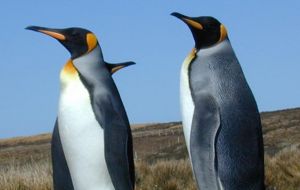MercoPress. South Atlantic News Agency
Fossil of giant penguin, double the size of an Emperor, found in Peru
 The scientists nicknamed the penguin “Pedro”
The scientists nicknamed the penguin “Pedro” The fossil of a giant penguin that lived 36 million years ago has been discovered in Peru. Scientists say the find shows that key features of the plumage were present quite early on in penguin evolution.
The team writes in Science journal that the penguin's feathers were brown and grey, distinct from the black “tuxedo” look of modern penguins.
It was nearly twice the size of an Emperor Penguin, the largest living species. The bird, named Inkayacu paracasensis, lived during the late Eocene period. It had a long, straight beak, much longer than that of its modern relatives.
The fossil was found in Reserva Nacional de Paracas in Peru. The scientists nicknamed the penguin “Pedro” - after a scaly character in a Colombian TV series. One of the highlights of the study was the presence of well-preserved feathers and scales.
“Before this fossil, we had no evidence about the feathers, colours and flipper shapes of ancient penguins,” said Julia Clarke, a palaeontologist at the University of Texas, US, and lead author of the study.
“We had questions and this was our first chance to start answering them.”
She explained to BBC News that the fossil also shows that penguins' main physical features evolved millions of years ago, but the colour of penguin feathers switched from reddish brown and grey to black-and-white quite recently.
It is the particular shape of flippers and feathers that makes penguins such powerful swimmers. During wing-propelled diving - the so-called aquatic flight - these birds are able to generate propulsive forces in an environment about 800 times denser and 70 times more viscous than air.
“One thing that's interesting in living penguins are that how deep they dive correlates with body size,” said Dr Clarke.
“The heavier the penguin, the deeper it dives. If that holds true for any penguins, then the dive depths achieved by these giant forms would've been very different.”
To get an idea about the colour of the feathers of the long-dead penguin, the team examined melanosomes - microscopic structures in the fossil, whose size, shape and arrangement determine the colour of a bird's feathers.
“Insights into the colours of extinct organisms can reveal clues to their ecology and behaviour,” said co-author Jakob Vinther of Yale University, US.
“But most of all, I think it is simply just cool to get a look at the colour of a remarkable extinct organism, such as a giant fossil penguin.”
The researchers say that the find, together with some other recent discoveries from the same area, is just another evidence of a rich diversity of giant penguin species in the late Eocene period of low-latitude Peru.
“This is an extraordinary site to preserve evidence of structures like scales and feathers,” said Dr Clarke.
”So there's incredible potential for new discoveries that can change our view not only of penguin evolution, but of other marine vertebrates” (BBC).-




Top Comments
Disclaimer & comment rules-

Read all commentsSo what is now Peru was once inhabited by 7ft penguins?
Oct 01st, 2010 - 09:56 am 0How cool is that?
Commenting for this story is now closed.
If you have a Facebook account, become a fan and comment on our Facebook Page!